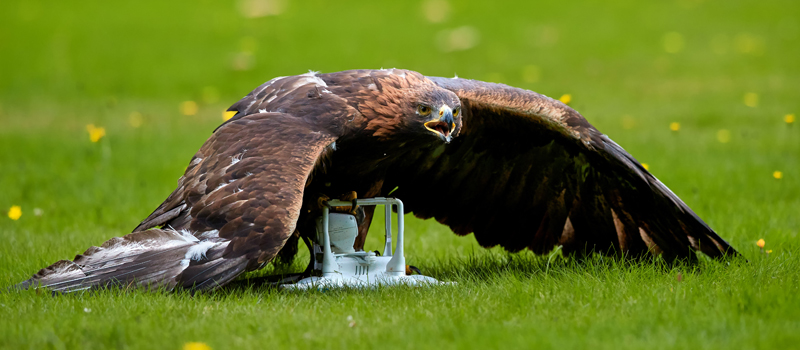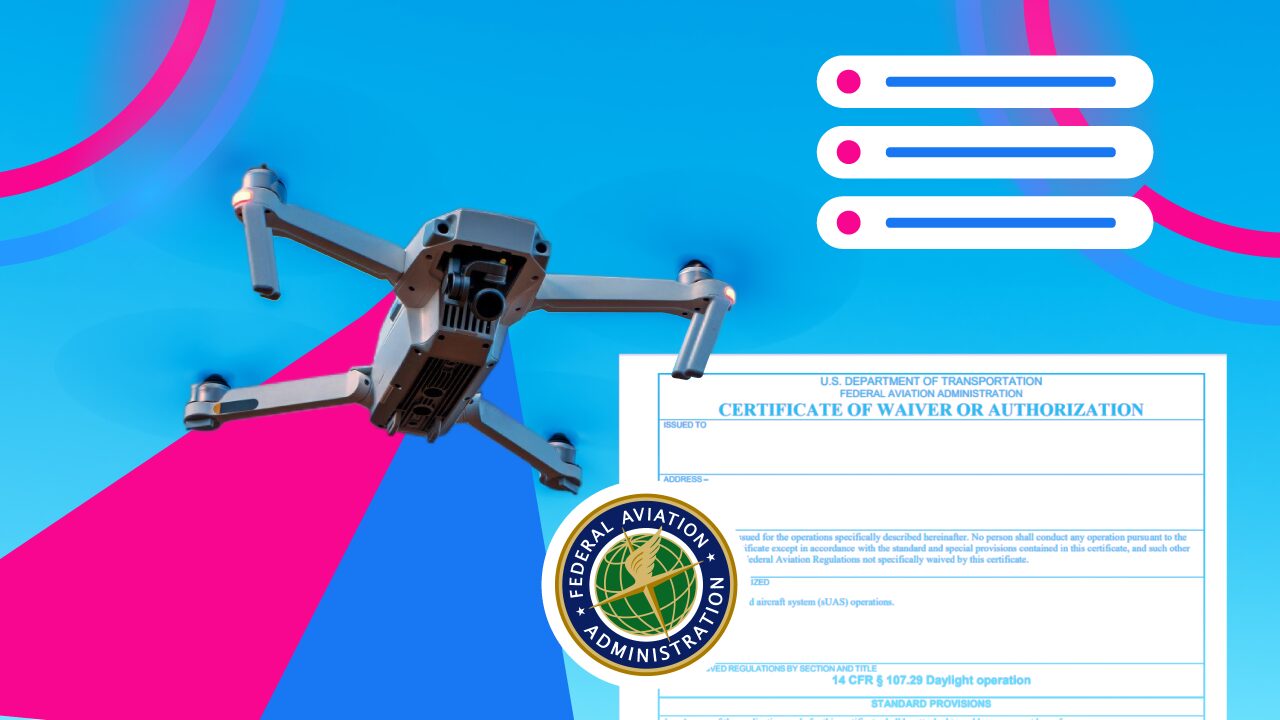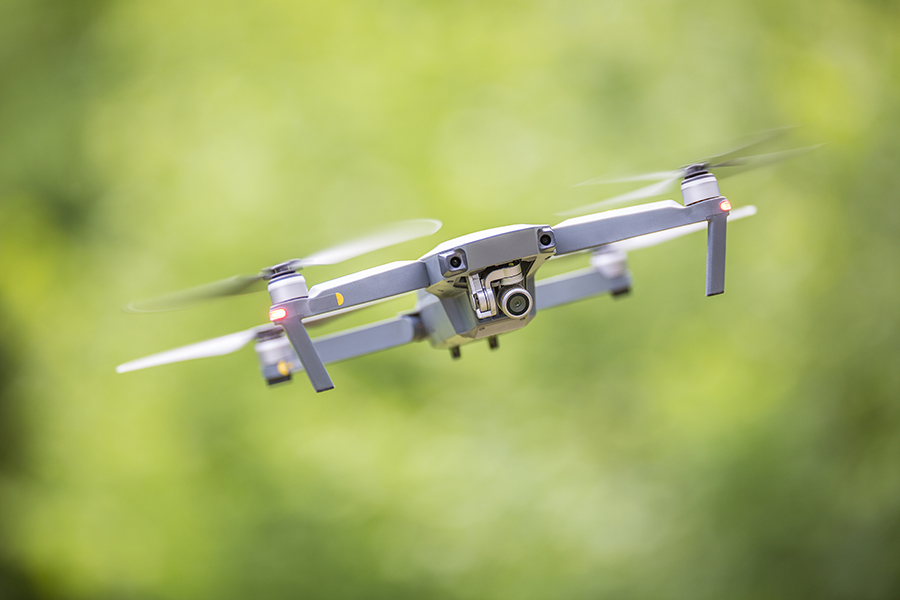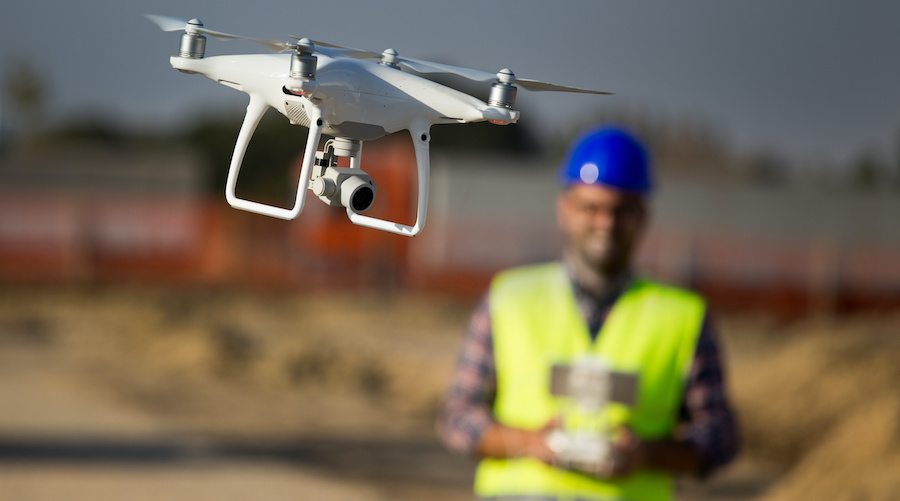-
How birds can be put in danger by drones
- Physical injury to birds
- Disruption of behaviors
-
Benefits of drones for bird populations
- Population monitoring
- Prevention of poaching
- Predictive models
- Driving birds away from airports
-
How can they co-exist?
- 1. Read up on wildlife laws
- 2. Check the local drone laws
- 3. Avoid large flocks of birds
- 4. Fly early in the morning
- 5. Stay away from feeding grounds
- 6. Research on seasonal activities
- 7. Use small and quiet drones
- 8. Use propeller guards
- 9. Avoid flying in the direction of birds
- 10. Stay at least 50 feet away
- 11. When threatened, fly out immediately
-
Final thoughts
Encounters between drones and birds are incredibly common, perhaps even to a disturbing degree. If you made a search for them now, you could probably find dozens of videos of drones being taken down by birds.
The presence of drones can disrupt the mating and migratory behaviors of birds and can even cause them to abandon their nests and they are young. Birds can also be injured by rotating parts of drones, especially when they are provoked to attack.
If your drone is attacked by a bird, your best bet is to climb vertically as fast as possible. Birds have a hard time flying straight up and this will confuse them.
Below we discuss tips on how to safely fly without your drone being attacked by birds.
How birds can be put in danger by drones
The conflict between drones and birds is inevitable. Before drones became as popular as they are nowadays, low-altitude airspace was almost solely the domain of birds. Encounters between manned aircraft and birds used to happen but were not as common.
The massive surge in the popularity of drones has made bird encounters more frequent. Now that drones are being used for many commercial applications, we can expect even higher levels of conflict. If mitigating measures aren’t put in place, how will drone use affect the health of birds and their population?
Physical injury to birds
The propellers of drones are known to be sharp enough to cause skin to break. We have already seen photos of these happening to people. It’s not hard to imagine that the same injuries if a drone gets into an encounter with a bird.
In many cases, drones are attacked by birds because they are perceived as either threats or prey. This has happened with a variety of birds – eagles, ravens, and seagulls just to name a few. In almost all instances, the drone ends up at the losing end of such encounters.
However, just because a drone crashed because of a bird attack does not mean that the bird came out of the encounter unscathed. Lacerations can be lethal for birds, especially if they are injured to the point where they can no longer hunt, become easier prey, or cannot care for their young.
There are also incidents of drones simply colliding into birds, likely because of negligence on the part of the pilot. This underscores the possibility of injuring birds with drones, even if the bird themselves aren’t aggressive.
Disruption of behaviors
When drone presence is so persistent in an area, birds could perceive them as threatening enough that they need to relocate. This is very problematic if the area has already become the habitat for the bird population.
Driving birds away from a location can cause changes to their migratory behavior. If this happens during mating season, it could seriously compromise the population growth of the local bird population.
Birds could even abandon their young if there are drones flying around the nest that are perceived as threats. This will leave eggs or chicks vulnerable and unlikely to grow into adult birds. Again, this curtails the growth of the bird population.
These pointers only cover the risks of hurting the bird population through the use of drones. On the side of the drone pilot, an encounter with a bird is also unfortunate as it typically results in the drone getting destroyed. If you run a drone business, getting into frequent bird encounters isn’t just irresponsible – it’s also unsustainable for your business.
Benefits of drones for bird populations
The issue between drones and birds is not as simple as saying that drones are bad and should be avoided completely. We also need to consider how drones have been used to protect the population of birds and wildlife in general.
Population monitoring
Drones have several unique abilities that make them suitable for wildlife monitoring. They can fly through large areas quickly, are equipped with high-definition cameras, and can even have automatic subject-tracking features. These are useful when environmentalists need to monitor the population of certain groups of animals, including birds.
In this context, drones can even be considered less disruptive compared to other means of wildlife monitoring. Drones with zoom cameras or infrared imaging can keep track of animals even from very far. Not only is this less disruptive for the animals but also safer for environmentalists.
Prevention of poaching
Poaching remains one of the most serious threats to wildlife preservation, especially in Asia and Africa. As the 4th largest illegal trade in the world, efforts to prevent poaching need to be constantly elevated as poachers also become more bold and cunning.
Many local rangers and communities have turned to drone technology to help reduce poaching. The surveillance capabilities of drones, along with the fact that they can be deployed very quickly, have made them ideal tools in this battle.
Predictive models
More than just tools for monitoring, drones are also very valuable for data gathering. For wildlife preservation, drones can gather data such as vegetation distribution, the size of bodies of water, movement patterns of wildlife, and the areas where poachers are typically sighted. Working with these numbers, data scientists can come up with predictive models.
This ability becomes even more impressive when we consider that drone sensors can collect data that is not visible to the human eye. Through multispectral analysis, the health of vegetation in an area can be mapped and monitored. By doing in the natural habitat of wildlife, environmentalists and rangers can assess how healthy the environment of animals is and step in if necessary.
Driving birds away from airports
Aside from drones, birds also get into frequent encounters with manned airplanes. This is dangerous both for the bird and the passengers. Unfortunately, urban expansion has made airports attractive spots for birds to congregate.
It seems counter-intuitive, but some airports around the world have started using drones to drive away birds from airports. This augments other methods such as the use of recorded predator calls, lasers, and walking trained dogs through the area to act as predators. All these are done to hopefully modify the behavior of birds and prevent them from thinking of airports as safe havens.
Aside from all the ways that drones can be used for wildlife preservation, it also cannot be denied that drone operations now have tremendous commercial value. They have been widely used for mapping, 3D surveys, utility inspection, advertising, and filmmaking. It’s only a matter of time before automated drone deliveries become a thing. As drones become better and less expensive, they will become an even more pervasive element of low-altitude airspace.
How can they co-exist?
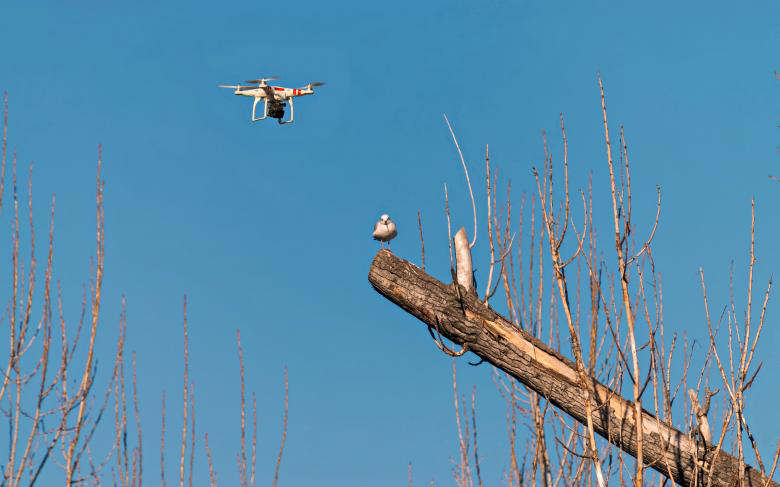
The issue of drones and birds is not clear-cut. While the welfare of birds can be compromised by the presence of drones, it also cannot be denied that drones continue to play an integral role in wildlife preservation and other humanitarian applications. This means that there has to be a middle ground – a way for drones to continue to operate without posing as much danger to birds.
In the last couple of years, several organizations have come up with recommendations for drone operators to help them manage conflicts with birds. While these rules aren’t exactly implemented by the FAA, we still recommend that drone pilots read through them and take them to heart. Here are a couple of tips that we have aggregated from several sources:
1. Read up on wildlife laws
If you fly your drone in an area with a lot of birds, then part of your responsibility is to read up on laws that can potentially be applicable to your operations. This includes laws that aim to protect wildlife from disruptive human activities. There are several such laws but we recommend starting your reading assignment with 16 US Code Chapter 35 (Endangered Species) and the Migratory Bird Treaty Act of 1918.
2. Check the local drone laws
Some cities or states may have special drone laws related to wildlife preservation. This is typically the case for areas with natural features or public parks that have become the habitat for birds and other forms of wildlife. Again, doing your own research or asking local authorities is part of your responsibility as a drone pilot.
3. Avoid large flocks of birds
Going through a pre-flight checklist should be part of any drone pilot’s procedure. Now that we know how drones can be disruptive to birds, you should now add another item to that checklist.
Just scan the immediate surroundings and check if there are any flock of birds flying around. If they linger in the area, then there’s a good chance that they will be staying there to feed, for mating, or to take care of their young. In this case, the responsible thing to do would be to relocate away from the birds.
4. Fly early in the morning
If relocating is not an option, another alternative is to simply schedule your operations for a time of day when birds aren’t as active. This is typically early in the morning when it’s still cold outside. This is because birds use thermals to generate lift more efficiently. This is a case where you have to be even earlier than the early bird.
5. Stay away from feeding grounds
The good thing about dealing with animals is that their behavior is fairly predictable. If you want to avoid carnivorous birds, then it would be best to stay away from feeding grounds. A good example is a large field with little vegetative cover where field mice or other small mammals could be abundant.
6. Research on seasonal activities
Birds operate on fairly consistent seasonal patterns. At a certain point of the year, birds can migrate from one area into another. One seasonal activity you need to be wary of is mating season.
During mating season, birds tend to become more aggressive when faced with threats. Male birds can see your drone as a rival, while female birds can perceive your drone as a threat to their nests. Either way, your drone is so much more likely to get attacked.
If you aren’t sure about the seasonal activities of birds in your area, then it would be best to consult with the local wildlife organization. Again, the behavior of birds is predictable and local experts probably already know when these seasonal activities start and end.
7. Use small and quiet drones
Flying close to birds is actually not a problem, especially if you or a visual observer can make sure that you do not collide with them accidentally. The real issue comes up when birds see your drone as a threat and attack it. To avoid this, many bird experts recommend that you use a drone that is as small and quiet as possible.
The good news is that there are now a lot of drones that fall under this category. The surge in popularity of ultra-portable drones should make drone flight near birds a lot safer. Keep in mind that maintaining a distance buffer from birds is still recommended, even if you’re flying a very small drone.
8. Use propeller guards
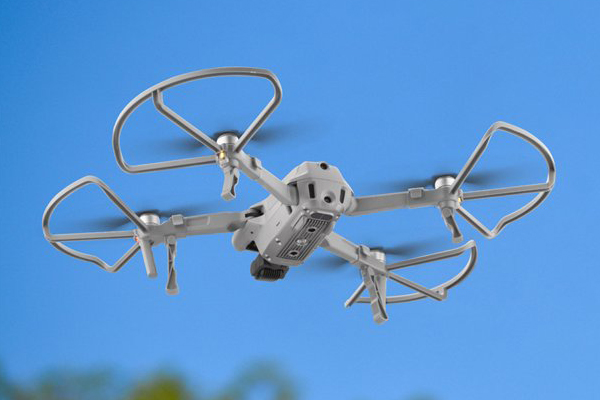
If there is even a remote possibility of a bird encounter, the least you could do is place some propeller guards on your drone. This isn’t for the protection of your drone, but that of the birds. In the grand scheme of things, it is so much more important than the bird comes out unscathed should a bird-and-drone encounter happen.
9. Avoid flying in the direction of birds
Birds are driven by primal instinct. If they see something as a threat, they will either attack in return or retreat. Either way, this manipulation of the behavior of birds can only be detrimental to their survival.
As a drone pilot, the safest flight pattern when flying near drones is to not fly directly in their direction. A rapid approach can be interpreted by birds as predatory behavior, and they will react based on their natural instincts. If you really must fly closer, do so with a maneuver that combines a roll with a very gradual approach.
10. Stay at least 50 feet away
Ideally, you should not be flying anywhere near birds. However, it might be unavoidable in certain places and situations. Even if this were the case, you should try and fly a safe distance from any bird or animal for that matter. A minimum of 50 feet is recommended, but 100 feet is more ideal.
At this distance, the drone becomes less of a threat to the birds. Even if the bird were to attack from this distance, the buffer should give you enough time to react and retreat. Despite that, you need to be on high alert whenever there are birds near your drone – they can still close that distance very quickly.
11. When threatened, fly out immediately
You don’t have to be a bird expert to sense when a bird attack is imminent. Birds of prey will typically fly circles around the potential prey before attacking. One thing to keep in mind is that they often attack from above, using their powerful talons as their primary weapons.
Should you find yourself in such a situation, then doing evasive maneuvers will be your best option. The first move is to fly up – birds typically will not try to attack from below. This maneuver also tends to confuse birds as a vertical altitude increase is a very unnatural motion, especially for prey.
Whatever you do, do not attempt to reduce altitude in the presence of a predatory bird. Doing so practically invites the bird to divebomb your drone. Birds can dive very quickly, and you likely won’t be able to maneuver your drone out of the way.
Once you have enough altitude, fly out of the area quickly until you are in a place where you can safely land. Birds are territorial and will likely lose interest if you fly away far enough from their area.
As with almost all drone safety practices, preparation is key for avoiding bird encounters. Do your research, scan the surroundings, and know-how to retreat properly if birds get aggressive.
Final thoughts
As the original aviators, birds deserve to have a safe space in the sky. No value of the commercial activity can justify disturbing the habitat of birds or disrupting their natural behavior.
Part of being a responsible drone pilot is knowing how your activities can affect wildlife behavior. Some of these may not even be that obvious to us. Increased drone activity in an area can cause birds to stop foraging there, leading to poor nutrition for their flock. The worst thing that can happen is that drones drive birds away from their nests, effectively abandoning their eggs.
Current laws on public parks, state parks, and wildlife preservation provide legal guidance for where drone activities can be done. Considering how many bird attacks on drones still happen, these laws apparently are not enough. The shift towards autonomous drone flight is even more concerning, as the lack of a human element can make bird encounters more common.
